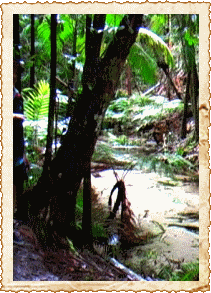skip to main |
skip to sidebar
FRASER ISLAND QLD AUSTRALIA
 Named after shipwreck victim Eliza Fraser
It was formed during the ice age when the prevailing winds transported vast quantities of sand from New South Wales and deposited it along the coast of Queensland forming Fraser Island as we know it today.
Fraser Island is also home to over 200 species of birds along with a variety of mammals, wallabies, snakes, possums,dingoes, turtles and flying foxes.
Fraser Island stretches over 123 kilometres in length and 22 kilometres at its widest point. With an area of 184 000 hectares it is the largest sand island in the world.
Fraser Island ranks with Australia's Uluru, Kakadu and the Great Barrier Reef. Fraser Island is a precious part of Australia's natural and cultural heritage, it is protected for all to appreciate and enjoy.
Fraser island is a place of exceptional beauty, with its long uninterrupted white beaches flanked by strikingly coloured sand cliffs, and over freshwater lakes, some tea-coloured and others clear and blue all ringed by white sandy beaches. Ancient rainforests grow in sand along the banks of fast-flowing, crystal-clear creeks.
Fraser Island is the only place in the world where tall rainforests are found growing on sand dunes at elevations of over 200 metres. The low "wallum" heaths on the island are of particular evolutionary and ecological significance, and provide magnificent wildflower displays in spring and summer.
The immense sand blows and cliffs of coloured sands are part of the longest and most complete age sequence of coastal dune systems in the world and they are still evolving.
They are a continuous record of climatic and sea level changes over the last 700 000 years. The highest dunes on the island reach up to 240 metres above sea level.
Named after shipwreck victim Eliza Fraser
It was formed during the ice age when the prevailing winds transported vast quantities of sand from New South Wales and deposited it along the coast of Queensland forming Fraser Island as we know it today.
Fraser Island is also home to over 200 species of birds along with a variety of mammals, wallabies, snakes, possums,dingoes, turtles and flying foxes.
Fraser Island stretches over 123 kilometres in length and 22 kilometres at its widest point. With an area of 184 000 hectares it is the largest sand island in the world.
Fraser Island ranks with Australia's Uluru, Kakadu and the Great Barrier Reef. Fraser Island is a precious part of Australia's natural and cultural heritage, it is protected for all to appreciate and enjoy.
Fraser island is a place of exceptional beauty, with its long uninterrupted white beaches flanked by strikingly coloured sand cliffs, and over freshwater lakes, some tea-coloured and others clear and blue all ringed by white sandy beaches. Ancient rainforests grow in sand along the banks of fast-flowing, crystal-clear creeks.
Fraser Island is the only place in the world where tall rainforests are found growing on sand dunes at elevations of over 200 metres. The low "wallum" heaths on the island are of particular evolutionary and ecological significance, and provide magnificent wildflower displays in spring and summer.
The immense sand blows and cliffs of coloured sands are part of the longest and most complete age sequence of coastal dune systems in the world and they are still evolving.
They are a continuous record of climatic and sea level changes over the last 700 000 years. The highest dunes on the island reach up to 240 metres above sea level.
 The Great Sandy Strait, separating Fraser Island from the mainland, is listed by the Convention on Wetlands of International Importance (Ramsar Convention).
The wetlands include: rare patterned ferns; mangrove colonies; sea-grass beds; and up to 40,000 migratory shorebirds. Rare, vulnerable or endangered species include dugongs, turtles, Illidge's ant-blue butterflies and eastern curlews.
The Great Sandy Strait, separating Fraser Island from the mainland, is listed by the Convention on Wetlands of International Importance (Ramsar Convention).
The wetlands include: rare patterned ferns; mangrove colonies; sea-grass beds; and up to 40,000 migratory shorebirds. Rare, vulnerable or endangered species include dugongs, turtles, Illidge's ant-blue butterflies and eastern curlews.
 Dingoes have killed humans here but it was believed the animals were annoyed by two legged animals; no action was taken
Dingoes have killed humans here but it was believed the animals were annoyed by two legged animals; no action was taken
 Named after shipwreck victim Eliza Fraser
It was formed during the ice age when the prevailing winds transported vast quantities of sand from New South Wales and deposited it along the coast of Queensland forming Fraser Island as we know it today.
Fraser Island is also home to over 200 species of birds along with a variety of mammals, wallabies, snakes, possums,dingoes, turtles and flying foxes.
Fraser Island stretches over 123 kilometres in length and 22 kilometres at its widest point. With an area of 184 000 hectares it is the largest sand island in the world.
Fraser Island ranks with Australia's Uluru, Kakadu and the Great Barrier Reef. Fraser Island is a precious part of Australia's natural and cultural heritage, it is protected for all to appreciate and enjoy.
Fraser island is a place of exceptional beauty, with its long uninterrupted white beaches flanked by strikingly coloured sand cliffs, and over freshwater lakes, some tea-coloured and others clear and blue all ringed by white sandy beaches. Ancient rainforests grow in sand along the banks of fast-flowing, crystal-clear creeks.
Fraser Island is the only place in the world where tall rainforests are found growing on sand dunes at elevations of over 200 metres. The low "wallum" heaths on the island are of particular evolutionary and ecological significance, and provide magnificent wildflower displays in spring and summer.
The immense sand blows and cliffs of coloured sands are part of the longest and most complete age sequence of coastal dune systems in the world and they are still evolving.
They are a continuous record of climatic and sea level changes over the last 700 000 years. The highest dunes on the island reach up to 240 metres above sea level.
Named after shipwreck victim Eliza Fraser
It was formed during the ice age when the prevailing winds transported vast quantities of sand from New South Wales and deposited it along the coast of Queensland forming Fraser Island as we know it today.
Fraser Island is also home to over 200 species of birds along with a variety of mammals, wallabies, snakes, possums,dingoes, turtles and flying foxes.
Fraser Island stretches over 123 kilometres in length and 22 kilometres at its widest point. With an area of 184 000 hectares it is the largest sand island in the world.
Fraser Island ranks with Australia's Uluru, Kakadu and the Great Barrier Reef. Fraser Island is a precious part of Australia's natural and cultural heritage, it is protected for all to appreciate and enjoy.
Fraser island is a place of exceptional beauty, with its long uninterrupted white beaches flanked by strikingly coloured sand cliffs, and over freshwater lakes, some tea-coloured and others clear and blue all ringed by white sandy beaches. Ancient rainforests grow in sand along the banks of fast-flowing, crystal-clear creeks.
Fraser Island is the only place in the world where tall rainforests are found growing on sand dunes at elevations of over 200 metres. The low "wallum" heaths on the island are of particular evolutionary and ecological significance, and provide magnificent wildflower displays in spring and summer.
The immense sand blows and cliffs of coloured sands are part of the longest and most complete age sequence of coastal dune systems in the world and they are still evolving.
They are a continuous record of climatic and sea level changes over the last 700 000 years. The highest dunes on the island reach up to 240 metres above sea level.
 The Great Sandy Strait, separating Fraser Island from the mainland, is listed by the Convention on Wetlands of International Importance (Ramsar Convention).
The wetlands include: rare patterned ferns; mangrove colonies; sea-grass beds; and up to 40,000 migratory shorebirds. Rare, vulnerable or endangered species include dugongs, turtles, Illidge's ant-blue butterflies and eastern curlews.
The Great Sandy Strait, separating Fraser Island from the mainland, is listed by the Convention on Wetlands of International Importance (Ramsar Convention).
The wetlands include: rare patterned ferns; mangrove colonies; sea-grass beds; and up to 40,000 migratory shorebirds. Rare, vulnerable or endangered species include dugongs, turtles, Illidge's ant-blue butterflies and eastern curlews.
 Dingoes have killed humans here but it was believed the animals were annoyed by two legged animals; no action was taken
Dingoes have killed humans here but it was believed the animals were annoyed by two legged animals; no action was taken











No comments:
Post a Comment